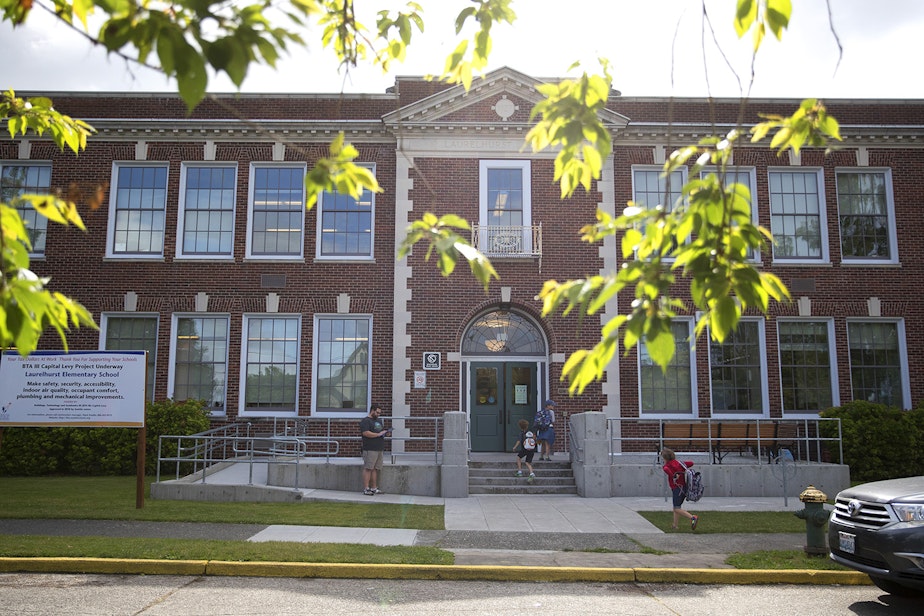20 Seattle elementary schools could be closed due to budget crisis

Updated at 7:50 p.m. 5/8/2024
Twenty Seattle elementary schools could be closed for the 2025-26 school year, Seattle Public Schools leadership announced on Wednesday.
District officials have not said which schools will be on the chopping block — a list is expected to be released in June — but they say K-5 students would be better accommodated if the district downsized to 50 elementary schools, down from more than 70 schools.
The plan does not include any middle or high school closures, and it’s not set in stone. The board is expected to vote in the fall.
This reorganization of schools comes as the district faces a $105 million shortfall next school year, and similar shortfalls for the next several years.
The district’s precarious financial situation has been fueled by declining enrollment, including a loss of nearly 5,000 students over the last five years. Because state education funding is largely based on enrollment numbers, that five-year drop cost the district about $81 million of revenue.
The district has framed these closures – or “consolidations” – not just as a way to balance the budget, but also as a means to create more equity across the schools.
While some schools have additional staff – such as nurses, special education staff, librarians, art teachers, and social workers – other schools may not, or may have those positions for limited hours.
Superintendent Brent Jones told the board Wednesday he initially had reservations about school closures, because he knew how difficult it would be for the community.
But as he and his staff explored options for getting the district on more solid financial footing, Jones said he came to believe that “we have to be efficient so that we can be effective.”
“I’m convinced that bringing us to a smaller footprint is going to allow us to do more things,” he said. “If we shore up our foundation, we have much more opportunity to be excellent.”
“I think it’s our duty to really bring our system into stability,” he added.
But some parents and community members don’t see it that way. During public comment at Wednesday's board meeting, several speakers urged the board to reject any plans for school closures.
“To be blunt, this is a bad plan intended to execute a flawed strategy built on incorrect assumptions,” said Ben Gitenstein, a parent and former candidate for school board, who argued it would “fracture neighborhoods, deepen distrust of the district, and pit communities against each other.”
Gitenstein also said the district should focus on its failures to address its “revenue problem” caused by chronic underfunding at the state level and dwindling enrollment.
“The problem is not about buildings. It’s not about formulas. It is about community,” Gitenstein said. “When every community considers their local public school the default option for their kids, our enrollment will grow and we will have the political will to force state legislators to fund education sufficiently.”
Others took issue with a lack of community engagement while district leaders built this plan, dubbed "well-resourced schools."
The district held a series of community meetings last summer to help form a vision for a “system of well-resourced schools." Administrators said Wednesday they plan to hold a series of community information sessions in May and June.
“The well-resourced schools plan as it exists so far has been put together with minimal public participation,” said Robert Cruickshank, a parent of three kids in the district.
“This plan needs to be the result of close collaboration with the families, students, and educators at the heart of this district.”
Some questioned why the bulk of community engagement opportunities are scheduled during summer break.
“That is a time that is really challenging for school communities and families to engage in school-related stuff,” said Alex Wakeman Rouse, a leader of the parent advocacy group All Together for Seattle Schools.
Besides closing schools in 2025 and beyond, district leaders are considering a number of other belt-tightening options, including:
- Changing school start times;
- Cutting central office staffing;
- Cutting school staff;
- Changes to transportation;
- Program adjustments and restructuring;
- And seeking philanthropic donations; among others.
Seattle Public Schools currently has 105 schools, including 29 schools with fewer than 300 students.
Last year, the district grappled with — and ultimately filled — a $131 million shortfall by draining a $42 million rainy day fund and making more than $30 million in cuts in the central office.
This year, officials are considering tapping reserves for a second year in a row. The board voted Wednesday to allow administrators to borrow up to $35 million from the district’s capital building fund.
The move is called an interfund loan, and the district will need to repay the fund, with interest, by June 2026.
Other proposals include delaying the repayment of the rainy day fund they drained last year and changing school start times in 2025 from the current two-bell system to three bells — something parents rebelled against the last time it was proposed.
The district has operated on a two-bell system since 2016. It was part of an effort to start the school day later for teens, who need more sleep than younger kids. But district officials recently said switching back to three bells could save the district about $9 million.
The district is also considering some opportunities to generate revenue, including by once again charging students to participate in sports — a move district officials believe could raise up to $1.1 million.
Related: Facing another budget deficit and possible closures, Seattle Public Schools seeks community feedback
Related: Here’s when Seattle Public Schools will announce school closures
Isolde Raftery contributed reporting.




